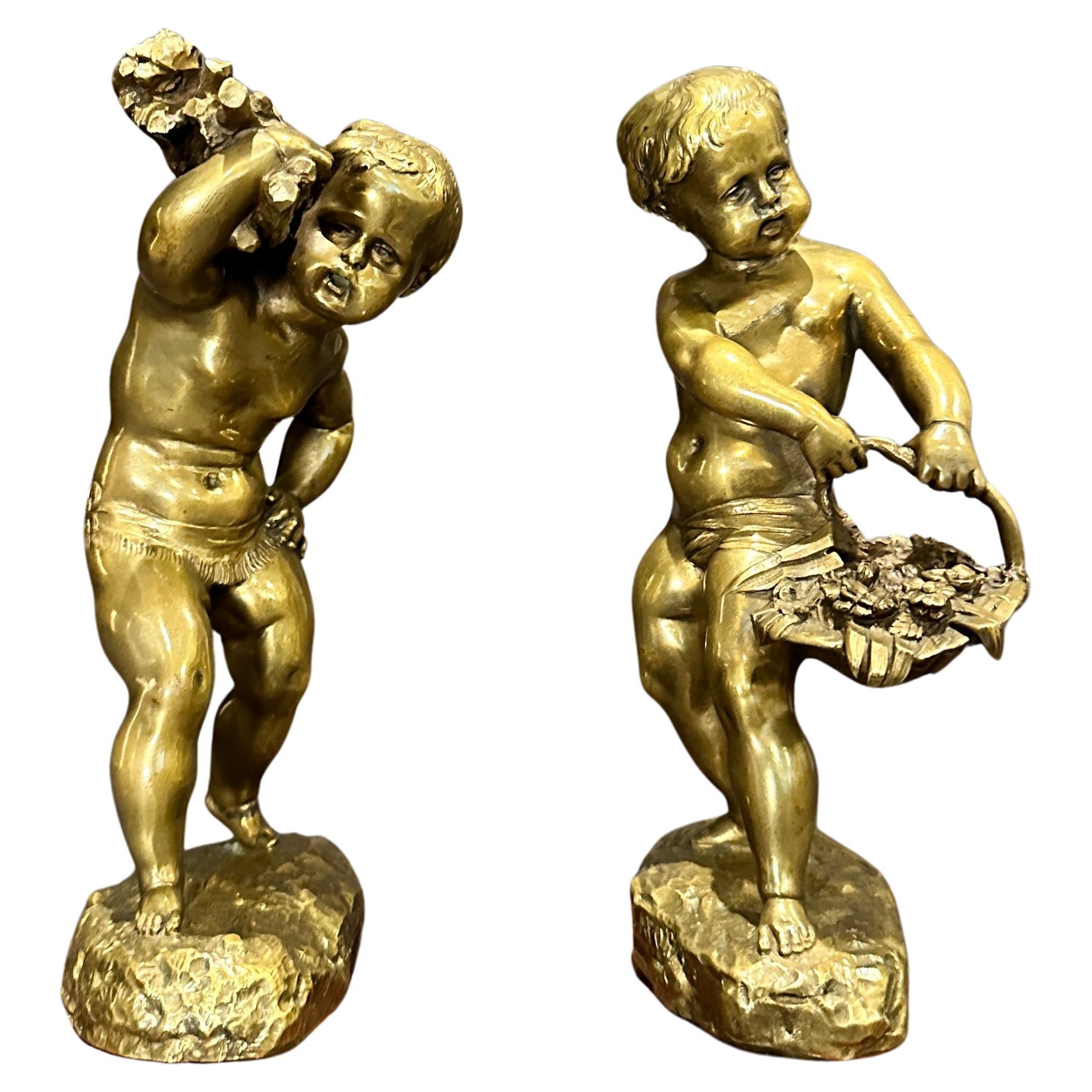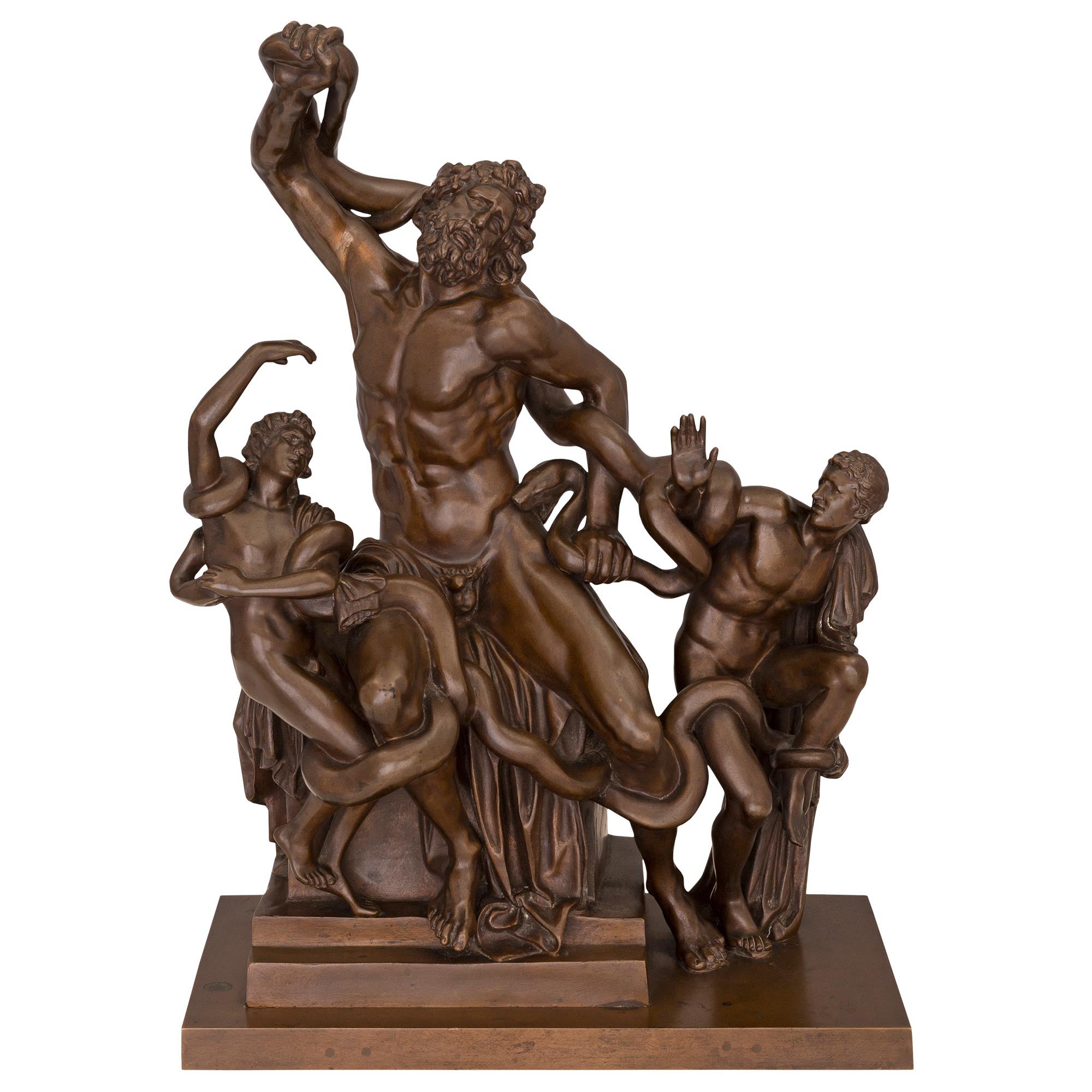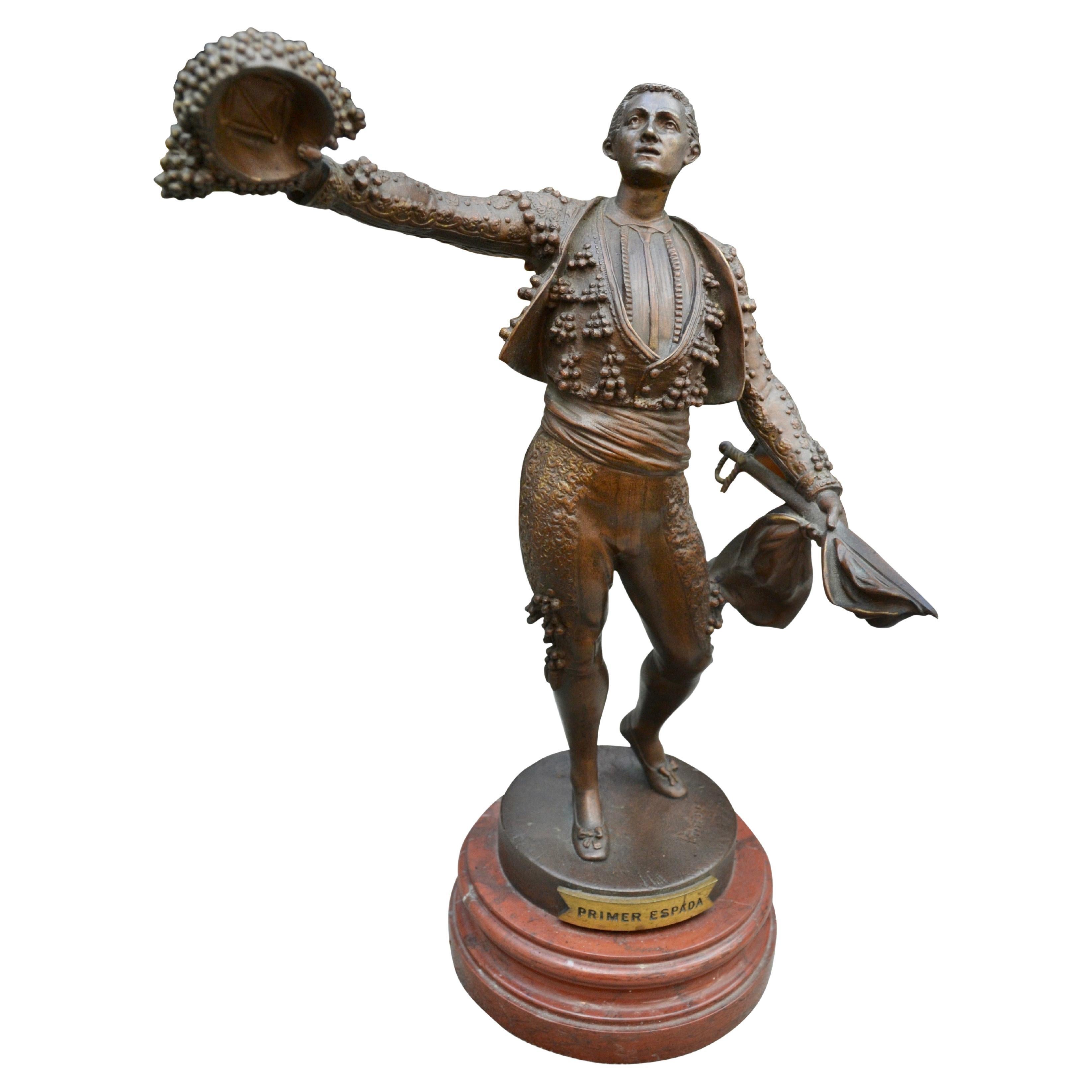Items Similar to Antique Bronze of Vercingetorix with His Son by Emile Laporte 19th C
Video Loading
Want more images or videos?
Request additional images or videos from the seller
1 of 22
Antique Bronze of Vercingetorix with His Son by Emile Laporte 19th C
About the Item
This is a large French bronze sculpture of Vercingetorix with his son by Emile Laporte (1858 - 1901), circa 1890 in date.
The standing figure of Vercingetorix wearing a winged helmet, with arm raised pointing into the distance, a figure of a of his son at his side, holding an axe in his right hand, raised on a rectangular naturalistically cast base, signed and numbered M585 & Salon Des Beaux Arts, Paris on the base.
Emile Laporte was a French sculptor (1858 Paris to 1907) who attended the Academy in Paris and was a student of Gabriel-Jules Thomas, Augustin Dumont, Jean-Marie Bonnassieux and Louis-Ernest Barrias.
Hi exhibited his work at the Salon of French artists from 1881, his last work exhibited there dates from 1905.
The attention to detail is absolutely fantastic and the sculpture is extremely life-like.
Condition:
In really excellent condition, please see photos for confirmation.
Dimensions in cm:
Height 61 x Width 42 x Depth 35
Dimensions in inches:
Height 2 foot x Width 1 foot, 4 inches x Depth 1 foot, 2 inches
In 53 BC, when Caesar had left for Italy after the summer campaign season, the Gallic tribes rebelled under the leadership of Vercingetorix, who raised an army against the Roman legions still wintering in Gaul. Hearing of the rebellion, Caesar crossed the mountains in the south, digging through snow drifts six feet deep, to rejoin his troops. "The very vigour and speed of his march in such wintry conditions," says Plutarch, "was a sufficient advertisement to the natives that an unconquered and unconquerable army was bearing down upon them" (Life of Julius Caesar, XXVI.3). To deprive the Romans of food and supplies, Vercingetorix had ordered a scorched-earth policy, and all the neighboring villages and farms were burned, "until fires were visible in all directions." But one tribe, already having torched twenty towns in a single day, refused to destroy its capital at Avaricum (Bourges), "almost the finest in Gaul, the chief defense and pride of their state."
Vergingetorix relented and set about to help defend the fortified town, which held a large supply of grain so desperately needed by the Romans. Caesar began a siege that lasted twenty-seven days. It now was early spring 52 BC, and, in spite of incessant rain, two wheeled towers, eighty-feet high, and ramps 330 feet long, over which they could be rolled into place, as well as a high siege terrace, were constructed in less than a month. The Gauls did all they could to counter or destroy the siege works. As the towers increased in height, so the defenders raised their own. They attacked the soldiers at work and tunneled under the terrace to undermine it. As the terrace approached the height of the wall, the defenders became desperate. Caesar writes that "They felt that the fate of Gaul depended entirely on what happened at that moment, and performed before our eyes an exploit so memorable that I felt I must not leave it unrecorded." It was almost midnight when they again had dug under the terrace and set it on fire. Opposite one of the towers, a Gaul was throwing pitch and tallow onto the fire when he was killed by an arrow from a catapult. Another man stepped forward to take his place and he, too, was killed. Another came forward and also was killed. This continued throughout the night until the fire finally was extinguished.
The next day, it began to rain heavily and, as the defenders took shelter, one of the siege towers was moved into position. The Gauls, taken by surprise, were dislodged from the walls and, panicked at the sight of the Romans surrounding them, threw down their weapons and fled. Exasperated at the length and difficulty of the siege, the Romans massacred the inhabitants. No-one was spared, "neither old men nor women nor children. Of the whole population—about forty thousand—a bare eight hundred who rushed out of the town at the first alarm got safely through to Vercingetorix."
Later that year, Vercingetorix and his men were trapped in the stronghold of Alesia, near present-day Dijon. Caesar surrounded the oppidum and began to construct siege works. The defenders had food only for a month, and Caesar hoped to starve them into surrender before reinforcements could arrive. The circumvallation extended around the town for ten miles, too large to be occupied by the Romans. It therefore was made more secure by a series of defenses. First, facing the town, a trench twenty-feet wide was dug to protect against surprise attack. Six hundred and fifty yards behind this ditch two more trenches were dug, each fifteen feet wide and the inner one filled with water. Behind these trenches was a palisaded rampart twelve feet high, with a breastwork of earth studded with forked branches. Around the entire circuit of the wall, towers were erected every 130 yards.
Still, there were attacks by the Gauls, and the siege works were strengthened even more. Tree trunks and strong branches were cut and sharpened, and buried securely in rows in front of the trenches. In front of them, diagonal rows of pits also were dug, each three-feet deep with a thick sharpened stake at the bottom and covered with brush to hide the trap. And, in front of these, blocks of wood were buried in the ground with iron barbs (stimuli) fixed in them. Aware that Vercingetorix had sent for reinforcements to break the siege, Caesar had an similar line of defense constructed facing outward to protect against attack from a relief force. By now, the food in the town had been exhausted, and it was determined that all those who could not fight were to be turned out. The inhabitants of Alesia, who had given refuge to Vercingetorix and his men, now were compelled to leave the town, together with their wives and children. Starving, they beseeched the Romans on the surrounding walls to take them in as slaves. But the population was refused any refuge and left to die of hunger between the two armies.
Caesar writes that 250,000 infantry and 8,000 cavalry assembled to relieve the besieged town. But the Gauls had difficulty communicating across the Roman siege works that ringed the oppidum and were not able to coordinate their efforts. Now surrounded, themselves, the Romans were able to repel the first assault. At midnight the next day, the Gauls suddenly attacked again, and Vercingetorix led his men out of the town in support. But it was too dark to see and, when the relief army came nearer the Roman defenses, "they suddenly found themselves pierced by the goads or tumbled into the pits and impaled themselves, while others were killed by heavy siege spears discharged from the rampart and towers." Before he could even reach the trenches, Vercingetorix heard the army retreating and was forced back behind the town walls. Again, the relief force reassembled: "The Gauls knew that unless they broke through the lines they were lost; the Romans, if they could hold their ground, looked forward to the end of all their hardships.... on that day, he said, on that very hour, depended the fruits of all their previous battles." There was a desperate struggle. The Gauls filled the trenches with dirt and bundles of sticks, pulled down the breastworks with hooks, and drove the Romans from the towers. But Caesar, his presence marked by a scarlet cloak, attacked with cavalry and additional cohorts. The Gauls broke and fled, the relieving army giving up and returning to their homes.
Vercingetorix was forced to surrender and presented himself to Caesar. Confined and transported to Rome, he languished in the Tullianum for five years before being killed as part of his victor's triumph in 46 BC. Two years later, Caesar, himself, was dead.
Our reference: A2905.
- Dimensions:Height: 24.02 in (61 cm)Width: 16.54 in (42 cm)Depth: 13.78 in (35 cm)
- Materials and Techniques:
- Place of Origin:
- Period:
- Date of Manufacture:circa 1890
- Condition:
- Seller Location:London, GB
- Reference Number:
About the Seller
5.0
Platinum Seller
These expertly vetted sellers are 1stDibs' most experienced sellers and are rated highest by our customers.
Established in 1983
1stDibs seller since 2012
1,199 sales on 1stDibs
Typical response time: <1 hour
Associations
LAPADA - The Association of Arts & Antiques Dealers
- ShippingRetrieving quote...Ships From: London, United Kingdom
- Return PolicyA return for this item may be initiated within 14 days of delivery.
More From This SellerView All
- Antique Library Bronze of Napoleon Bonaparte 19th CenturyLocated in London, GBThis is a finely cast brown patinated bronze Grand Tour sculpture of Napoleon Bonaparte, Mid 19th Century in date. It features Napoleon standing contrapposto in uniform wearing a...Category
Antique 1850s Figurative Sculptures
MaterialsBronze
- Antique Grand Tour Patinated Bronze Figure of of David 19th CLocated in London, GBThis is a superb large antique Grand Tour patinated bronze version of David, dating from the mid 19th Century. The bronze statue depicts David with an enigmatic smile posed with ...Category
Antique 1850s Figurative Sculptures
MaterialsBronze
- Antique Bronze Sculpture of the Dying Gaul by B Boschetti Rome, 19th CenturyBy Benedetto BoschettiLocated in London, GBThis is a truly magnificent antique Italian Grand Tour figural golden patinated bronze sculpture depicting a wounded gladiator known as "The Dying Gaul", and signed B Boschetti...Category
Antique 1830s Italian Figurative Sculptures
MaterialsBronze
- Antique Victorian Bronze Sculpture of Greek God Apollo 19th CenturyLocated in London, GBThis is a truly magnificent antique Victorian patinated bronze sculpture of the famous Greek God Apollo, modelled upon a shaped circular socle, inscribed monogram 'NF' and numbered 2...Category
Antique 1860s English Victorian Figurative Sculptures
MaterialsBronze
- Antique Monumental Grand Tour Bronze of Michelangelo David, 19th CenturyLocated in London, GBThis is an elegant monumental Grand Tour bronze sculpture of Michelangelo's David, circa 1880 in date. The full-length portrait statue is of David, the 14ft marble statue depicts the Biblical hero David, represented as a standing male nude, David looks tense and ready for battle after he has made the decision to fight Goliath, but, before the battle has actually taken place. His brow is drawn, his neck tense, and the veins bulge out of his lowered right hand and holding his slingshot over his shoulder. This impressive scuplture is 107cm (3ft 6" ) tall and weighs over 36kgs (79lbs). This high quality hot cast solid bronze was produced using the traditional 'lost wax' process. The attention to detail of this sculpture is absolutely fantastic. Condition: In really excellent condition, please see photos for confirmation. Dimensions in cm: Height 107 x Width 41 x Depth 24.5 Weight 36.3 kg Dimensions in inches: Height 3 foot, 6 inches x Width 1 foot, 4 inches x Depth 10 inches Weight 80.0 lbs Michelangelo's David This astonishing Renaissance sculpture was created between 1501 and 1504. It is a 14ft marble statue depicting the Biblical hero David, represented as a standing male nude. Originally commissioned by the Opera del Duomo for the Cathedral of Florence, it was meant to be one of a series of large statues to be positioned in the niches of the cathedral’s tribunes, way up at about 80mt from the ground. Michelangelo was asked by the consuls of the Board to complete an unfinished project begun in 1464 by Agostino di Duccio and later carried on by Antonio Rossellino in 1475. Both sculptors had in the end rejected an enormous block of marble due to the presence of too many “taroli”, or imperfections, which may have threatened the stability of such a huge statue...Category
Antique 1880s Figurative Sculptures
MaterialsBronze
- Antique Pair of French Bronze Marly Horses Sculptures by Cousteau 19th CenturyLocated in London, GBThis is a fine antique pair of French Grand Tour patinated-bronze sculptures of the Marly Horses, Circa 1850 in date and signed to one base. The original Marly Horses were commissi...Category
Antique 1850s French Grand Tour Figurative Sculptures
MaterialsBronze
You May Also Like
- Pair Of Bronze Sculptures/Bookends By Emile LaporteBy Emile LaporteLocated in Norwood, NJ19th century French bronze sculptures of young farm boys by Emile Laporte (1858 - 1907), France. One boy carrying a basket of flowers, the other a bundle of sticks. Signed, mounted o...Category
Antique Late 19th Century French Belle Époque Figurative Sculptures
MaterialsMarble, Bronze
- French 19th Century Patinated Bronze Statue of Laocoön and His SonsBy Ferdinand BarbedienneLocated in West Palm Beach, FLA most impressive and high quality French 19th century patinated bronze statue of Laocoön and his sons, signed Barbedienne. The bronze is raised b...Category
Antique 19th Century French Figurative Sculptures
MaterialsBronze
- Large Patinated Bronze Figure of Actaeon by Emile LaporteBy Emile LaporteLocated in London, GBLarge patinated bronze figure of Actaeon by Emile Laporte French, late 19th century Measures: height 84cm, width 42cm, depth 44cm By the French arti...Category
Antique Late 19th Century French Belle Époque Figurative Sculptures
MaterialsBronze
- A Continental 19th century bronze & ormolu statues by Emile GuilleminLocated in West Palm Beach, FLA lovely and high quality true pair of small scale Continental 19th century patinated, silvered bronze and ormolu statues by Emile Guillemin. Each statue is raised by a circular mott...Category
Antique 19th Century French Figurative Sculptures
MaterialsBronze, Ormolu
- 19th Century Bronze Statue of a Matador in a Victory Salute by Emile PinedoBy Émile PinedoLocated in Vancouver, British ColumbiaThis may well be the finest cast bronze we are offering. Please note the matador's delicate facial features as well as the intricate details of his costume. The artist, Emile Pinedo...Category
Antique Late 19th Century French Other Figurative Sculptures
MaterialsBronze
- 'Seated Minstrel' a Late 19th Century Bronze Sculpture by Emile BoisseauLocated in Forest Row, East Sussex'Seated Minstrel' A late 19th century bronze sculpture by Emile Boisseau (1842-1923) depicting a seated Troubadour in traditional costume playing the lute. Rich light brown patina. S...Category
Antique Late 19th Century French Late Victorian Figurative Sculptures
MaterialsBronze





